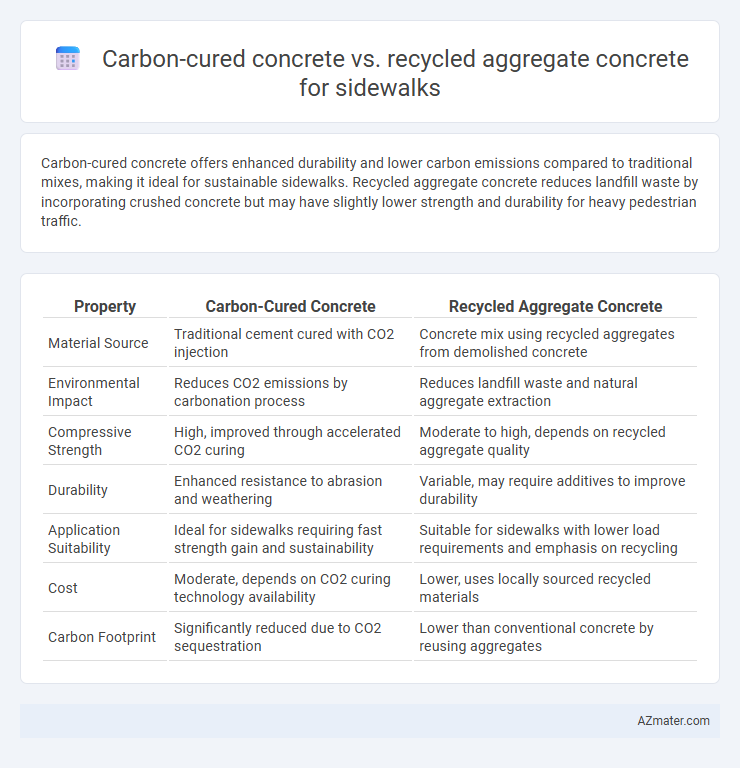Carbon-cured concrete offers enhanced durability and lower carbon emissions compared to traditional mixes, making it ideal for sustainable sidewalks. Recycled aggregate concrete reduces landfill waste by incorporating crushed concrete but may have slightly lower strength and durability for heavy pedestrian traffic.
Table of Comparison
| Property | Carbon-Cured Concrete | Recycled Aggregate Concrete |
|---|---|---|
| Material Source | Traditional cement cured with CO2 injection | Concrete mix using recycled aggregates from demolished concrete |
| Environmental Impact | Reduces CO2 emissions by carbonation process | Reduces landfill waste and natural aggregate extraction |
| Compressive Strength | High, improved through accelerated CO2 curing | Moderate to high, depends on recycled aggregate quality |
| Durability | Enhanced resistance to abrasion and weathering | Variable, may require additives to improve durability |
| Application Suitability | Ideal for sidewalks requiring fast strength gain and sustainability | Suitable for sidewalks with lower load requirements and emphasis on recycling |
| Cost | Moderate, depends on CO2 curing technology availability | Lower, uses locally sourced recycled materials |
| Carbon Footprint | Significantly reduced due to CO2 sequestration | Lower than conventional concrete by reusing aggregates |
Introduction to Sustainable Sidewalk Materials
Carbon-cured concrete offers enhanced durability and reduced carbon footprint by utilizing CO2 sequestration in the curing process, making it a sustainable choice for sidewalks. Recycled aggregate concrete incorporates crushed construction waste, lowering the demand for virgin materials and minimizing landfill use, thereby promoting resource efficiency. Both materials represent innovative approaches to sustainable sidewalk construction, balancing environmental benefits with structural performance.
Overview of Carbon-Cured Concrete Technology
Carbon-cured concrete technology utilizes carbon dioxide gas during the curing process to accelerate strength development and enhance durability by increasing the concrete's density. This innovative method not only reduces the carbon footprint by sequestering CO2 but also improves the mechanical properties, making it suitable for sidewalk applications requiring long-lasting performance. Compared to recycled aggregate concrete, carbon-cured concrete offers superior compressive strength and resistance to environmental degradation, optimizing sustainability and durability for urban infrastructure.
Understanding Recycled Aggregate Concrete
Recycled Aggregate Concrete (RAC) incorporates crushed concrete and masonry from demolition waste, making it a sustainable choice for sidewalks by reducing landfill use and conserving natural resources. This concrete type maintains adequate strength and durability for pedestrian pathways while lowering environmental impact compared to traditional mixes. RAC's porous nature can improve drainage and resist freeze-thaw cycles, enhancing sidewalk longevity in varying climates.
Environmental Benefits Comparison
Carbon-cured concrete significantly reduces CO2 emissions by capturing and storing carbon dioxide during the curing process, resulting in lower embodied carbon compared to conventional materials. Recycled aggregate concrete leverages reclaimed construction waste, reducing landfill impact and resource extraction but may have a higher carbon footprint due to energy-intensive processing. Evaluating environmental benefits for sidewalks, carbon-cured concrete offers superior carbon sequestration, while recycled aggregate concrete emphasizes waste reduction and resource circularity.
Structural Performance and Durability
Carbon-cured concrete exhibits enhanced structural performance and superior durability for sidewalks due to its accelerated curing process, which results in higher early strength and reduced permeability. Recycled aggregate concrete, while promoting sustainability by reusing construction waste, often shows variable mechanical properties and may require careful mix design to achieve comparable durability and load-bearing capacity. Optimizing carbonation levels and aggregate quality in carbon-cured concrete can lead to longer-lasting sidewalks with improved resistance to freeze-thaw cycles and chemical attacks compared to recycled aggregate concrete.
Cost Analysis and Economic Viability
Carbon-cured concrete typically incurs higher initial costs due to specialized curing equipment and CO2 sourcing, but it offers long-term savings through increased durability and reduced maintenance. Recycled aggregate concrete benefits from lower raw material expenses by utilizing waste materials, enhancing its economic viability in cost-sensitive sidewalk projects. Evaluating lifecycle costs, recycled aggregate concrete presents a more affordable solution upfront, whereas carbon-cured concrete may yield better investment returns over time through enhanced sustainability and performance.
Carbon Footprint Reduction Assessment
Carbon-cured concrete significantly lowers carbon footprints by actively sequestering CO2 during the curing process, capturing up to 20-30% of emissions compared to conventional methods. Recycled aggregate concrete reduces environmental impact by reusing construction waste, cutting raw material extraction, and lowering embodied carbon by approximately 15-25%. When assessed for sidewalk applications, carbon-cured concrete offers superior carbon footprint reduction, while recycled aggregate concrete provides a sustainable balance of resource efficiency and lower emissions.
Installation and Maintenance Considerations
Carbon-cured concrete offers faster installation due to accelerated curing times, reducing project duration for sidewalks, and requires minimal maintenance because its dense matrix resists cracking and surface degradation. Recycled aggregate concrete may have longer installation times due to variable curing behavior and often needs more frequent maintenance to address potential permeability and durability issues from heterogeneous aggregate composition. Both materials demand careful quality control during batching and mixing to optimize performance and longevity in sidewalk applications.
Case Studies and Real-World Applications
Case studies highlight carbon-cured concrete's superior durability and reduced carbon footprint compared to traditional methods, making it ideal for sidewalk construction in urban areas aiming for sustainability. Real-world applications of recycled aggregate concrete demonstrate cost-efficiency and effective waste reduction while maintaining adequate strength and durability for pedestrian pathways. Both materials contribute to eco-friendly sidewalk projects, with carbon-cured concrete excelling in performance and recycled aggregate concrete offering practical resource reuse benefits.
Future Trends in Eco-Friendly Sidewalk Construction
Carbon-cured concrete offers enhanced durability and significant carbon capture benefits, making it a promising option for eco-friendly sidewalk construction. Recycled aggregate concrete reduces landfill waste by reusing crushed concrete materials, contributing to sustainable resource management and lowering the carbon footprint of urban infrastructure. Future trends prioritize hybrid approaches combining carbon curing technology with recycled aggregates to optimize environmental impact and performance in sidewalk projects.

Infographic: Carbon-cured concrete vs Recycled aggregate concrete for Sidewalk
 azmater.com
azmater.com